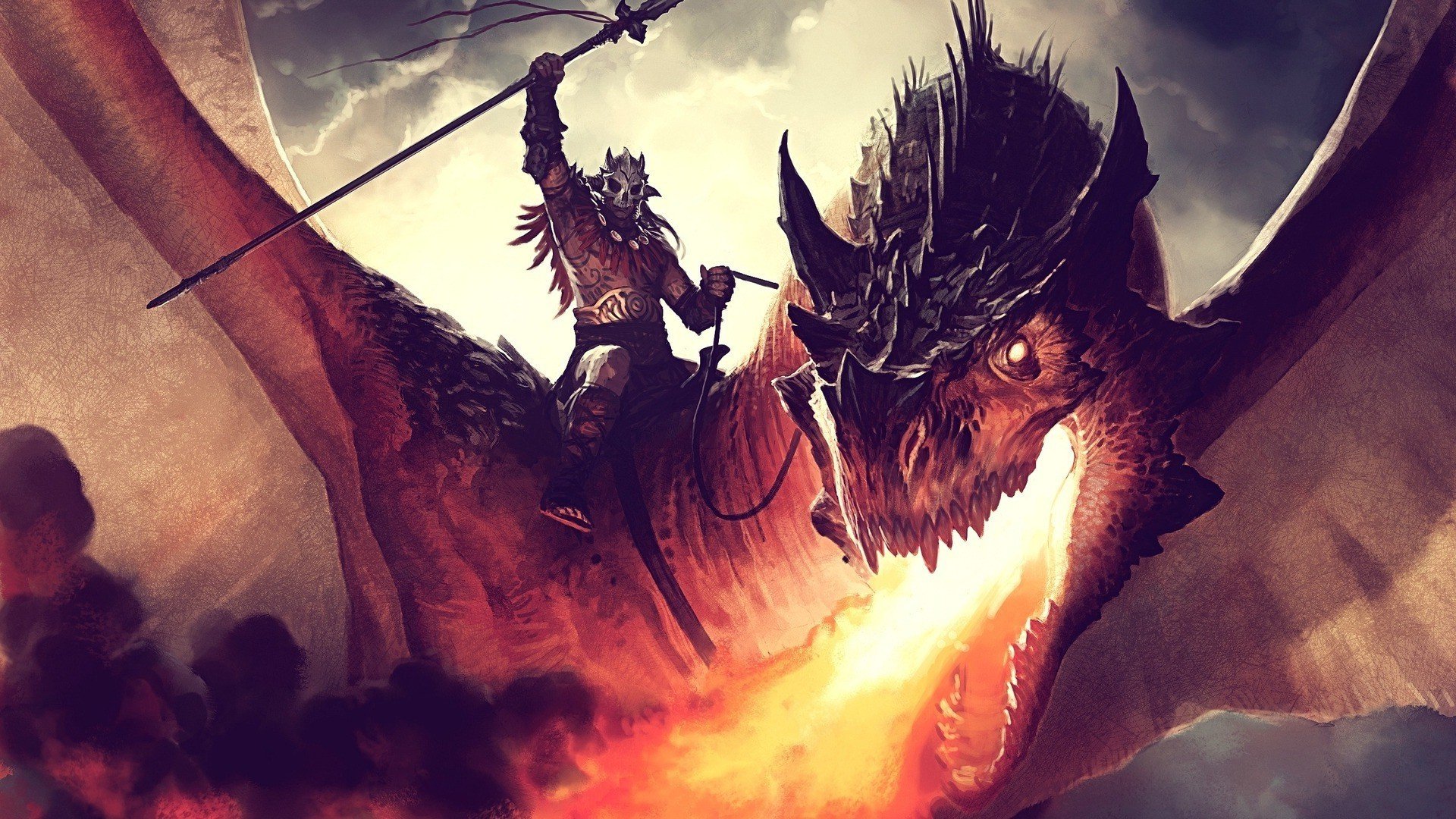Before dinosaurs became a thing, my two favorite creature types were hydras and dragons. That really hasn’t changed. I’ve found that hydras have a harder time conforming to an effective deck (which hasn’t stopped me from running a good chunk of them in my Animar EDH deck), but thanks to MTG’s ageless love for dragons, the Khans block, and the recent Ur-Dragon Commander deck release, there’s plenty of dragon love to work with for a tribal dragon EDH deck…well…in my case…two EDH decks. This is the first rendition that focuses on the “original” color identity for dragons – Jund – made popular in the Alara block.
Jund (Red/Green/Black) dragons are all about aggressive, big, flying creatures laying down hellfire and brimstone on the opponent and their creatures. The color combination allows for heavy aggro (Red), removal and graveyard shenanigans (Black), and mana ramping and fixing (Green). It’s the perfect color combination for some killer dragons, led by the original Jund dragon Commander, Karrthus, Tyrant of Jund.
Other popular Jund Commanders are Prossh, Skyraider of Kher and Kresh the Bloodbraided. Both work well together featured around the Devour mechanic. I’ve chosen to avoid this mechanic, and the dragons associated with it, to not be forced to run a ton of dragon fodder. It is what it is. But if you prefer more synergy in your EDH decks beyond tribal, you may want to look there.
Decklist
- Commander
- Karrthus, Tyrant of Jund
- Creatures
- Kilnmouth Dragon
- Kolaghan, the Storm’s Fury
- Atarka, World Render
- Dragonlord Atarka
- Dragonlord Kolaghan
- Bladewing the Risen
- Utvara Hellkite
- Scourge of Valkas
- Dragon Broodmother
- Hellkite Overlord
- Stormbreath Dragon
- Hoard-Smelter Dragon
- Wasitora, Nekoru Queen
- Darigaaz, the Igniter
- Thundermaw Hellkite
- Balefire Dragon
- Skithiryx, the Blight Dragon
- Bogardan Hellkite
- Thunderbreak Regent
- Avaricious Dragon
- Knollspine Dragon
- Hellkite Tyrant
- Flameblast Dragon
- Deathbringer Regent
- Vampiric Dragon
- Moonveil Dragon
- Savage Ventmaw
- Hellkite Charger
- Two-Headed Dragon
- Siege Dragon
- Furyborn Hellkite
- Tyrant’s Familiar
- Harbinger of the Hunt
- Spellbreaker Behemoth
- Charnelhoard Wurm
- Gruul Ragebeast
- Dragon Whisperer
- Kargan Dragonlord
- Dragon’s Herald
- Dragonmaster Outcast
- Dragonspeaker Shaman
- Dragonlord’s Servant
- Planeswalkers
- Ugin, the Spirit Dragon
- Sarkhan the Mad
- Sarkhan Vol
- Sarkhan, the Dragonspeaker
- Artifacts
- Quicksilver Amulet
- Darksteel Ingot
- Chromatic Lantern
- Enchantments
- Gruul War Chant
- Asceticism
- Crucible of Fire
- Dragon Tempest
- Dragon Roost
- Instants and Sorceries
- Sarkhan’s Triumph
- Descent of the Dragons
- Dragonstorm
- Crux of Fate
- Fearsome Awakening
- Lands
- Haven of the Spirit Dragon
- Command Tower
- Crucible of the Spirit Dragon
- Ancient Ziggurat
- Opal Palace
- Rupture Spire
- Savage Lands
- Dragonskull Summit
- Overgrown Tomb
- Rootbound Crag
- Cinder Glade
- Hissing Quagmire
- Temple of Malice
- Golgari Guildgate
- Rakdos Guildgate
- Gruul Guildgate
- Mountain x8
- Swamp x8
- Forest x8
Dragon tribal EDH isn’t terribly fancy in its approach. Play big, bad creatures with aggressive abilities and go on the offensive. There is little complexity. The dragons and their beneficiaries and assists supply plenty of synergy to be effective against most opponents. What they lack in versatility and mana curve efficiency they make up for with sheer power and direct aggression to player and creature alike.
The creatures are dragon-heavy with a handful of creatures that feed the style (Spellbreaker, Ragebeast, Charnelhoard) or help in casting (Dragonspeaker Shaman, Dragonlord’s Servant).
The dragons themselves have plenty of built-in removal and damage, so it’s unnecessary to go heavy on that in the instants/sorceries department. So instead it’s about field wipes, graveyard recovery, and tutoring.
The artifacts are primarily for mana ramping/fixing. The Quicksilver Amulet is an underrated beast. It provides mana “fixing” (colorless cost), mana “ramping” (makes creatures cheaper), “Flash” ability (can be used at instant speed), and counter immunity (the creature placed isn’t cast).
The enchantments are especially dragon savvy. Dragon Tempest is of particular awesomeness. It gives dragons haste and deals direct damage to creatures or players equal to the number of dragons you have in play every time you play a dragon. Mixed in with the other enchantments are Menace, power/toughness buffs, and Hexproof/Regenerate.
This deck, like all of my EDH decks, doesn’t have a direct or designed win condition. I just believe the format isn’t designed for that, though “win condition” in EDH may be a gray area and others may disagree. Regardless, this deck isn’t designed to win on a certain turn or fish out an easy victory. What it does have is a fun little combo that synergizes incredibly well with the Commander, if you happen to have 13 mana and hit the one card necessary. Play Descent of the Dragons, target all of your opponents’ creatures, then play Karrthus. So, essentially what you do is destroy all of your opponents’ creatures, replace them with 4/4 dragons, then play Karrthus and take control of all the dragons and attack with everything. It’s a nasty maneuver, though easily foiled with counterspells, hexproof and/or indestructible.
The deck tends to be one of my stronger decks in group games of Commander, but like my Esper Sphinx deck, it tends to be a bit too slow for 1-on-1. It doesn’t like control in general, but can go toe-to-toe with most other decks, especially ones that try to keep up with it on the battlefield.
The aggressive, big creature dependence of the deck makes it struggle against heavy doses of control and/or removal, and it can’t keep up with the synergy/versatility of the angels. But, with the release of the Ur-Dragon and the Tarkir block, the versatility of dragons has expanded, at the expense of running 5 colors. I have such a deck, and I’ll go over it in the near future.
–Dalton


